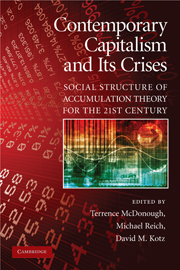Book contents
- Frontmatter
- Contents
- List of Tables
- List of Figures
- List of Contributors
- Acknowledgments
- Introduction: Social Structure of Accumulation Theory for the 21st Century
- PART I THE THEORY OF SOCIAL STRUCTURES OF ACCUMULATION
- 1 The State of the Art of Social Structure of Accumulation Theory
- 2 Social Structure of Accumulation Theory
- 3 A Reconceptualization of Social Structure of Accumulation Theory
- PART II GLOBALIZATION AND THE CONTEMPORARY SOCIAL STRUCTURE OF ACCUMULATION
- PART III THE CONTEMPORARY SOCIAL STRUCTURE OF ACCUMULATION IN THE UNITED STATES
- PART IV SOCIAL STRUCTURE OF ACCUMULATION THEORY AND TRANSFORMATIONS OF THE CAPITALIST PERIPHERY
- Index
- References
3 - A Reconceptualization of Social Structure of Accumulation Theory
Published online by Cambridge University Press: 05 June 2012
- Frontmatter
- Contents
- List of Tables
- List of Figures
- List of Contributors
- Acknowledgments
- Introduction: Social Structure of Accumulation Theory for the 21st Century
- PART I THE THEORY OF SOCIAL STRUCTURES OF ACCUMULATION
- 1 The State of the Art of Social Structure of Accumulation Theory
- 2 Social Structure of Accumulation Theory
- 3 A Reconceptualization of Social Structure of Accumulation Theory
- PART II GLOBALIZATION AND THE CONTEMPORARY SOCIAL STRUCTURE OF ACCUMULATION
- PART III THE CONTEMPORARY SOCIAL STRUCTURE OF ACCUMULATION IN THE UNITED STATES
- PART IV SOCIAL STRUCTURE OF ACCUMULATION THEORY AND TRANSFORMATIONS OF THE CAPITALIST PERIPHERY
- Index
- References
Summary
Introduction
Social structure of accumulation (SSA) theory is one of the most important theoretical innovations in heterodox economics. It makes sense of much of economic history. It links theoretical analysis with concrete institutional investigation. It provides a basis for understanding the evolution of capitalism over time, as well as institutional differences among capitalist systems in different countries. Not the least, SSA theory provides a basis for explaining the periodic severe economic crises that have arisen in capitalist history.
However, we believe that SSA theory has encountered difficulties in seeking to explain the economic reality of the past several decades. By most accounts, the postwar (post-World War II) SSA in the United States broke up in the late 1960s and early 1970s. After a decade of crisis and struggle, a new institutional structure was created, initially in the United States and the United Kingdom, which undermined government regulation and promoted capital mobility.
This model, which soon became dominant globally, is commonly referred to as neoliberalism. In the United States, neoliberalism has meant increased income inequality, deregulation of industrial and financial markets, increased influence of financial markets over corporate decision-making, fiscal policy emphasizing tax cuts for the wealthy and cutbacks in social programs, monetary policy that puts a greater emphasis on reducing inflation than unemployment, and relatively sluggish economic growth.
How can we understand neoliberalism in the context of SSA theory? Did a new SSA emerge in the neoliberal era?
- Type
- Chapter
- Information
- Contemporary Capitalism and its CrisesSocial Structure of Accumulation Theory for the 21st Century, pp. 72 - 90Publisher: Cambridge University PressPrint publication year: 2010
References
- 27
- Cited by



